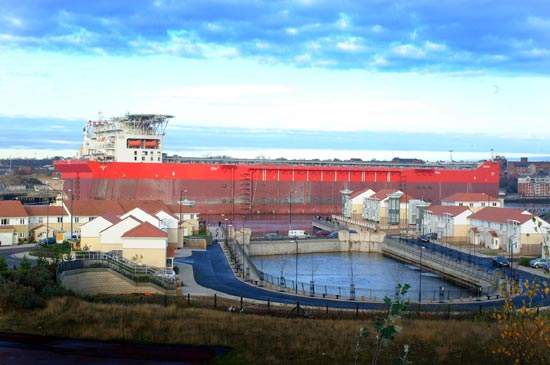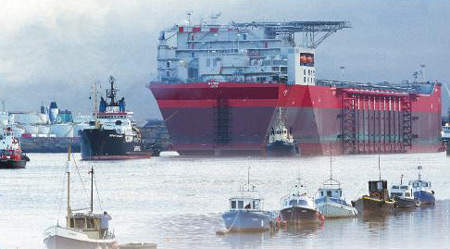The giant Bonga floating production, storage and offloading (FPSO) vessel is in use at Shell’s Bonga oilfield (discovered in 1993 and with a life of 20 years), which lies 120km off the coast of the Niger Delta, covering an area of 60km².
The vessel, which became operational in 2004, is permanently installed in water depths ranging from 1,000m to 1,125m.
The Bonga FPSO was built by Samsung Heavy Industries in Korea for the owner operator, Shell Nigeria Exploration and Production Company Limited (SNEPCo) and the Nigerian National Petroleum Corporation Shell.
Following the completion of the topside installation in 2004, the FPSO sailed to Nigeria and installed on Bonga by means of four groups of three mooring legs to begin operations. First oil production was made in November 2005.
In June 2008, an attack on the Bonga by Movement for the Emancipation of the Niger Delta militants resulted a shutdown of production for three weeks.
The vessel is classified by Lloyd’s Register of Shipping with the notation +180 floating production and offloading installation +OMC OIWS, IGS, CAAO, SBT, PL, CCCS, LI, ShipRight (SDA,FDV,CM,PCWBT) Helicopter Deck.
Bonga FPSO details
The hull has a length of 305.1m or 295m between perpendiculars. It has a moulded breadth of 58m. The design draught is 23.4m and it has a scantling draught of 23.9m.
After construction, the 47,200t hull was sailed to Tyneside for the process topsides to be installed by Amec at their Wallsend facility (the ship was one of the largest to ever enter the Tyne). This topside processing system, weighing some 22,000t, was installed on a deck elevated 5.5m above the main deck. Unladen the vessel has a displacement of 90,000t (with topsides installed) and fully laden she has a deadweight of 312,500t.
The width of its double skin is 5.4m. The Bongo FPSO is manned by a complement of four officers and 66 crew that are housed in four single and 33 double rooms.
Processing and storage on Bonga FPSO
The processing equipment installed can process 225,000 barrels of stabilised crude oil per day at a maximum tank temperature of 60°C. The crude is then exported into a shuttle tanker at a rate of 7,000m³/h (one million barrels per 24 hours).
The vessel is connected to 16 subsea oil production and water injection wells and the connections use inconel clad Steel Catenary Risers. This is the first time this type of riser has been used on any FPSO.
The Bonga FPSO has a storage capacity of 324,233m³ (two million barrels of crude oil). The FPSO will also have a gas export facility of 150 million standard cubic feet per day. It can also carry 10,970m³ of diesel oil as well as 138,131m³ of water ballast. Its double bottom is laid out as sludge tanks.
The oil is contained in 15 cargo tanks arranged in a 5 x 3 configuration, as well as five pairs of wing tanks full of water ballast. There are two diesel tanks, two methanol tanks and two slop tanks. The methanol tanks are separated from the other compartments by coffer dams.
The product is pumped by 15 hydraulic submersible pumps supplied by Framo, each with a capacity of 1,500m³/h. The cargo and ballast control system was supplied by Nakakita Siesa Kusho.
Propulsion and navigation of the Bonga FPSO
The vessel’s power is derived from two diesel driven AMG 630 S6 alternators, each with a capacity of 1,900kW at 1,000rpm. The machinery spaces are located under the accommodation deck.
The bridge contains two satellite navigation systems. This breaks down into one Inmarsat B unit and one Inmarsat-C T T 30 20 C Saturn B. There is also a FR-2105 radar system.
Safety and waste disposal systems
The safety systems include a Saracom Thorn addressable programmable fire detection system as well as several fire extinguishing systems. These include both a foam/saltwater system for the cargo tank deck and a water mist/saltwater system for the machinery room. The lifesaving equipment comprises five 50-person, totally enclosed lifeboats with water break protection.
The waste disposal system consists of an incinerator waste contractor and waste shredder crusher including a sewage plant.
Contractors involved
Samsung Heavy Industries was contracted for the construction of the FPSO.
The cargo and ballast control system was supplied by Nakakita Siesa Kusho.
The propulsion systems were provided by Wartsila while the alternators were supplied by ABB. The satellite communication systems were provided by Invsat.
The safety systems including fire detection and extinguishing systems were supplied by NK Fire Protection. Team Tec was awarded the contract to supply the waste disposal systems while the sewage plant was supplied by Hamworthy KSE.
In January 2021, Norwegian firm TMC Compressors was awarded a contract to supply a complete offshore topside compressed air system comprising three large compressors and control system to Shell’s Bonga Main FPSO in Nigeria.












